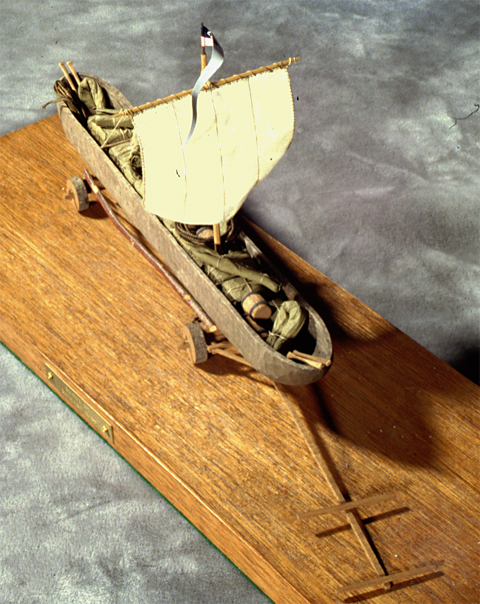Building Canoes
Eighty percent of the Corps of Discovery’s round-trip journey was by water, in a total of 25 vessels of various types—the custom-built military barge (called the ‘boat’ or ‘barge’ but never the ‘keelboat’), two large flat-bottomed rowboats called pirogues, fifteen dugout canoes made from logs, four canoes bought from Indians, one stolen Indian canoe, and two buffalo-skin bull boats. Altogether, the men carved 15 dugout canoes. At Fort Mandan they hewed 6 from cottonwood logs, which they paddled, poled, and towed up the Missouri to the Great Falls. When Lewis’s experimental “iron boat” failed above the falls, they carved two more cottonwood canoes to take its place. They abandoned one at the confluence of the Jefferson and Wisdom (today the Big Hole) Rivers, and stashed the rest at Fortunate Camp, where they transferred their baggage to horses purchased from the Lemhi Shoshones.
West of the Rockies they used ponderosa pine logs to craft five new canoes. One of those was wrecked in the Falls of the Columbia, and replaced with one the captains bought from Indians. The Corps left Fort Clatsop on 23 March 1806 in three of their own pine dugouts, four Indian canoes they bought, plus one they found. All were either sold or destroyed by the time they got through the Falls, where they bought horses for the overland journey back to the Nez Perce village where they had left their Shoshone horses. They carved one small ponderosa pine canoe at Long Camp for commuting back and forth across the Clearwater River, but it broke up on a rock and sank.
Back at Fortunate Camp in early July of 1806, Sergeant Ordway and eleven men retrieved their five cottonwood dugouts and paddled them down to the Great Falls of the Missouri. Meanwhile, Clark proceeded overland to the Yellowstone River and made two small dugouts a few miles above today’s Billings, which were so unstable he had them battened together, catamaran style.
Generally the dugouts were about thirty feet long and up to three feet wide, with a capacity of between two and three tons, including four to six men, who probably knelt in order to keep the center of gravity low and prevent tipping. Empty, each canoe may have weighed as much as a ton.
Portaging Dugouts
On 16 June 1805, at the lower portage camp (near today’s Belt Creek) below the Great Falls of the Missouri Meriwether the captains received “a very unfavourable report” concerning the prospect of portaging around the five falls. “As the distance was too great to think of transporting the canoes and baggage on the men’s shoulders, we scelected six men, and ordered them to look out [for] some timber this evening, and early in the morning to set about making a parsel of truck wheels in order to convey our canoes and baggage over the portage.”
One windy day during the portage, Clark wrote:
it maybe here worthy of remark that the Sales were hois[t]ed in the Canoes as the men were drawing them and the wind was great relief to them being Sufficently Strong to move the Canoes on the Trucks, this is Saleing on Dry land in every Sence of the word.
It is likely that all the canoes were fitted with masts of some sort. Back on the river a month later, suspecting that Indians were secretively watching them, Lewis remarked, “I ordered the canoes to hoist their small flags.” Those could either have been the “stars and stripes,” or else naval pennants such as Clark drew in his working sketch of the barge.
Circumstances favor the latter conclusion. The expedition was, after all, principally a waterborne journey, and was frequently—about 200 times, in fact—referred to in the journals as a voyage. On 7 April 1805, upon setting out again up the Missouri from Fort Mandan, Captain Lewis compared it somewhat whimsically with the voyages of two famous oceangoing explorers.
Our vessels consisted of six small canoes, and two large perogues. This little fleet altho’ not quite so rispectable as those of Columbus or Capt. Cook were still viewed by us with as much pleasure as those deservedly famed adventurers ever beheld theirs; and I dare say with quite as much anxiety for their safety and preservation.…we were now about to penetrate a country at least two thousand miles in width, on which the foot of civilized man had never trodden; the good or evil it had in store for us was for experiment yet to determine, and these little vessells contained every article by which we were to expect to subsist or defend ourselves.
Further reading
William W. Bevis, The Dugout Canoes of Lewis and Clark and Testing Dugout Canoes.
Richard C. Boss, “Keelboat, Pirogue, and Canoe: Vessels Used by the Lewis and Clark Corps of Discovery,” Nautical Research Journal, Vol. 38, No. 2 (June 1993), 68–87.
Arlen Large, “The Rocky Boat Ride of Lewis & Clark,” We Proceeded On, Vol. 21, No. 1 (February 1995), 16-23.
Experience the Lewis and Clark Trail
The Lewis and Clark Trail Experience—our sister site at lewisandclark.travel—connects the world to people and places on the Lewis and Clark Trail.
Discover More
- The Lewis and Clark Expedition: Day by Day by Gary E. Moulton (University of Nebraska Press, 2018). The story in prose, 14 May 1804–23 September 1806.
- The Lewis and Clark Journals: An American Epic of Discovery (abridged) by Gary E. Moulton (University of Nebraska Press, 2003). Selected journal excerpts, 14 May 1804–23 September 1806.
- The Lewis and Clark Journals. by Gary E. Moulton (University of Nebraska Press, 1983–2001). The complete story in 13 volumes.



